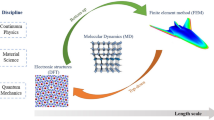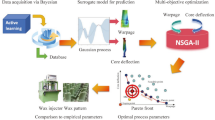Abstract
Simulation of metal forming processes using the Finite Element Method (FEM) is a well established procedure, being nowadays possible to develop alternative approaches, such as inverse methodologies, in solving complex problems. In the present paper, two types of inverse approaches will be discussed, namely the parameter identification and the shape optimization problems. The aim of the former is to evaluate the input parameters for material constitutive models that would lead to the most accurate set of results respecting physical experiments. The second category involves determining the initial geometry of a given specimen leading to a desired final geometry after the forming process. The purpose of the present work is then to formulate these inverse problems as optimization problems, introducing a straightforward methodology of process optimization in engineering applications such as metal forming and structural analysis. To reach this goal, an integrated optimization approach, using a finite element code together with a numerical optimization program, was employed. A gradient-based optimization method, as a combination of the steepest-descent method and the Levenberg-Marquardt techniques, was used. Numerical applications in the parameter optimization category include, namely, the characterization of a non-linear elasto-plastic hardening model and the determination of the parameters for a nonlinear hyperelastic model. It is also discussed the simultaneous identification of both constitutive material model parameters and the friction coefficient parameters. From the point of view of shape optimization problems, the determination of the initial geometry of a specimen in a upsetting billing problem as well as a methodology for defining the most suited blank shape to be formed in a square cup, are discussed. The final results for both categories show that this kind of algorithms have great potential for future developments in more demanding and realistic benchmarks. It is also worth noting that the presented integrated methodology can be easily applied to a first introduction of optimization techniques and numerical simulation to undergraduate courses in engineering.
Similar content being viewed by others
References
Abaqus v6.7 (2007) Simulia Inc, Dassault Systèmes
Amar G, Dufailly J (1993) Identification and validation of viscoplastic and damage constitutive equations. Eur J Mech A/Solids 12(2):197–218
Andrade-Campos A, Thuiller S, Pilvin P, Teixeira-Dias F (2007) On the determination of material parameters for internal variable thermoelastic-viscoplastic constitutive models. Int J Plast 23:1349–1379
Astrom KJ, Eykho P (1971) System identification: a survey. Automatica 7:123–162
Bard Y (1974) Nonlinear parameter estimation. Academy Press, New York
Cailletaud G, Pilvin P (1993) Identification and inverse problems: a modular approach. In: Bertram, Brown, Freed (eds) Material parameter estimation for modern constitutive equations, vol 43, pp 33–45. ASME Book
Cailletaud G, Pilvin P (1994) Identification and inverse problems related to material behaviour. In: Proc int seminar on inverse problems, Clamart, pp 79–86
Cao J, Lin J (2008) A study on formulation of objective functions for determining material models. Int J Mech Sci 50:193–204
Chaboche JL, Nouailhas D, Savalle S (1991) Agice: Logiciel pour l’identification interactive graphique des lois de comportement. Rech Aerosp 3:59–76
Fourment L, Chenot JL (1996) Optimal design for non-steady-state metal forming processes—II. Shape optimization method. Int J Numer Methods Eng 39:33–50
Fourment L, Balan T, Chenot JL (1996) Optimal design for non-steady-state metal forming processes—II. Application of shape optimization in forging. Int J Numer Methods Eng 39:51–65
Furukawa T, Yagawa G (1997) Inelastic constitutive parameter identification using evolutionary algorithm with continuous individuals. Int J Numer Methods Eng 40:1071–1090
Gelin JC, Ghouati O (1991) An inverse method for determing viscoplastic properties of aluminium alloys. J Mater Process Tech 45(1):435–440
Habraken AM (2004) Modelling the plastic anisotropy of metals. Arch Comput Methods Eng 11:3–96
Jansson T (2005) Optimization of sheet metal forming processes. PhD Dissertation No 936. Institute of Technology, Linkopings Universitet, Sweden
Kreibig R, Benedix U, Gorke U-J (2001) Statistical aspects of the identification of material parameters for elasto-plastic models. Arch Appl Mech 71:123–134
Kleinermann JP (2000) Identification parametrique et optimisation des procedes de mise a forme par problemes inverses. PhD Thesis. University of Liege
Lin J, Yang J (1999) GA-based multiple objective optimisation for determining viscoplastic constitutive equations for superplastic alloys. Int J Plast 15:1181–1196
Liu GR, Han X (2003) Computational inverse techniques in nondestructible evaluation. CRC Press, Boca Raton
Mahnken R, Stein E (1996) A unified approach for parameter identication of inelastic material models in the frame of the finite element method. Comput Methods Appl Mech Eng 136:225–258
Maniatty AM, Chen MF (1996) Shape sensitivity analysis for steady metal-forming processes. Int J Numer Methods Eng 39:1199–1217
Maniatty A, Zabaras N (1989) Method for solving inverse elastoviscoplatic problems. J Eng Mech 115(10):2216–2231
Maniatty AM, Zabaras N (1994) Investigation of regularization parameters and error estimating in inverse elasticity problems. Int J Numer Methods Eng 37:1039–1052
Marciniak Z, Duncan JL, Hu SJ (2002) Mechanics of sheet metal forming, 3rd edn. Springer, Berlin. Butterworth-Heinemann Editors
Marquardt DW (1963) An algorithm for least-squares estimation of non-linear parameters. J Soc Ind Appl Math 11:431–441
Martins JAC, Natal JRM, Ferreira AJM (2006) A comparative study of several material models for prediction of hyperelastic properties: application to silicone-rubber and soft tissues. Strain 42:135–147
Menezes LF, Teodosiu C (2000) Three-dimensional numerical simulation of the deep-drawing process using solid finite elements. J Mater Process Tech 97:100–106
Norris DM, Morran JRB, Scudde JK, Quinones DF (1978) A computer simulation of the tension test. J Mech Phys Solids 26:1–19
Oliveira MC, Alves JL, Menezes LF (2003) Improvements of a frictional contact algorithm for strongly curved contact problems. Int J Numer Methods Eng 58:2083–2101
Oliveira MC, Alves JL, Chaparro BM, Menezes LF (2007) Study on the influence of work-hardening modeling in springback prediction. Int J Plast 23:516–543
Papadrakakis M, Lagaros ND (2003) Soft computing methodologies for structural optimization. Appl Soft Comput 3:288–300
Parente MPL, Valente RAF, Jorge RMN, Cardoso RPR, Sousa RJA (2006) Sheet metal forming simulation using EAS solid-shell finite elements. Finite El Anal Des 42:1137–1149
Park JJ, Rebelo N et al. (1983) A new approach to preform design in metal forming with the finite element method. Int J Tool Des Res 1:71–79
Polak E (1997) Optimization—algorithms and consistent approximations. Springer, New York
Ponthot JP, Kleinermann JP (2006) A cascade optimization methodology for automatic parameter identification and shape/process optimization in metal forming simulation. Comput Methods Appl Mech Eng 195:5472–5508
Schmit LA (1960) Structural design by systematic synthesis. In: 2nd conf on electronic comput, pp 105–122. ASCE
Schmit LA, Malett RH (1963) Structural synthesis and design parameter hierarchy. J Struct Div, ASCE 89:269
Schnur D, Zabaras N (1992) An inverse method for determining elastic material properties and a material interface. Int J Numer Methods Eng 33:2039–2057
Simo JC (1998) A framework for finite strain elastoplasticity based on maximum plastic dissipation and the multiplicative decomposition. Comput Methods Appl Mech Eng 66:199–219
Tang SC, Pan J (2007) Mechanics modeling of sheet metal forming. Springer, Berlin. SAE International
Wagoner RH, Chenot JL (2001) Metal forming analysis. Cambridge University Press, Cambridge
Zhao KM, Lee JK (2004) Inverse estimation of material properties for sheet metals. Commun Numer Methods Eng 20:105–118
Author information
Authors and Affiliations
Corresponding author
Rights and permissions
About this article
Cite this article
Valente, R.A.F., Andrade-Campos, A., Carvalho, J.F. et al. Parameter identification and shape optimization. Optim Eng 12, 129–152 (2011). https://doi.org/10.1007/s11081-010-9126-y
Received:
Accepted:
Published:
Issue Date:
DOI: https://doi.org/10.1007/s11081-010-9126-y




